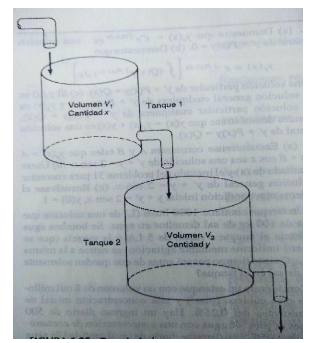¡Tu solución está lista!
Nuestra ayuda de expertos desglosó tu problema en una solución confiable y fácil de entender.
Mira la respuestaMira la respuesta done loadingPregunta: 1. In the “waterfall” shown in the drawing, tank 1 initially contains 100 gal of pure ethyl alcohol, and tank 2 initially contains 100 gal of pure water. Pure water flows into tank 1 at a rate of 10 gal/min, and at the drains (from both tanks) the outflow is also 10 gal/min. a) Find the functions for the amounts 𝑥(𝑡) and 𝑦(𝑡) of alcohol in each tank, at
1. In the “waterfall” shown in the drawing, tank 1 initially contains 100 gal of pure ethyl alcohol, and tank 2 initially contains 100 gal of pure water. Pure water flows into tank 1 at a rate of 10 gal/min, and at the drains (from both tanks) the outflow is also 10 gal/min. a) Find the functions for the amounts 𝑥(𝑡) and 𝑦(𝑡) of alcohol in each tank, at time t. b) Determine the maximum amount of alcohol that tank 2 has.
Solution guide for part (a): Step 1: Set up the model (an equation for each tank and the initial conditions) Step 2: Solve the differential equivalence of tank 1. Step 3: Substitute the result of Step 2 into the equation for tank 2. Step 4: Solve the equation you got in Step 3. You must argue (explain, justify) your entire solution process and answers.
1. En la “cascada” que se muestra en el dibujo, el tanque 1 contiene inicialmente 100 gal de alcohol etílico puro, y el tanque 2, contiene inicialmente 100 gal de agua pura. Al tanque 1 fluye agua pura a razón de 10 gal/min, y en los desagües (de ambos tanques) el flujo de salida es también de 10 gal/min.
-
a) Encuentra las funciones para las cantidades 𝑥(𝑡) y 𝑦(𝑡) de alcohol en cada tanque, al tiempo t.
-
b) Determina la máxima cantidad de alcohol que llega a tener el tanque 2.
Guía de solución para el inciso (a):
Paso 1: Plantea el modelo (una ecuación para cada tanque y las condiciones iniciales)
Paso 2: Resuelve la ecuación diferencial del tanque 1.
Paso 3: Sustituye el resultado del Paso 2 en la ecuación del tanque 2.
Paso 4: Resuelve la ecuación que obtuviste en el Paso 3.Debes argumentar (explicar, justificar) todo tu proceso de solución y las respuestas.
-
- Esta es la mejor manera de resolver el problema.Solución

Estudia mejor, ¡ahora en español!
Entiende todos los problemas con explicaciones al instante y pasos fáciles de aprender de la mano de expertos reales.

